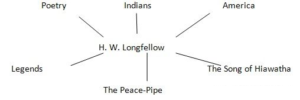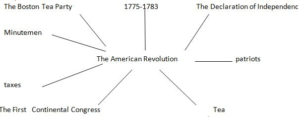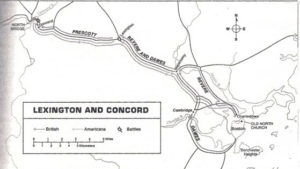American Literature Special Course
Topic: Henry Wadsworth Longfellow ,a Boston Brahmin and a Fireside Poet
Objectives: to get Ss interested in American poetry; to develop Ss’ reading and speaking skills; to revise the material about the founders of American literature; to practise Ss in reading poetry aloud
Materials: cassette recorder, cards for team competition, the text about H. W. Longfellow, the map and the poem “Paul Revere’s Ride
Procedure
Warming –up
Botticelli game: Student A thinks of one of the writers ( Washigton Irving, Fenimore Cooper, Harriet Beecher- Stowe, Edgar Allan Poe). Student B asks only “Yes” or “No” questions and tries to guess the name of the author. Student A is to answer “Yes” or “No”. He is allowed to say three times “Don’t know”. The fourth time he doesn’t know Student A has to tell the writer’s name.
Short revision of the covered material. Team competition
Teacher: At the previous lessons we spoke about the founders of American literature. Let’s see what you remember about these authors. You should split into two teams. Each team gets a card with four questions. One team reads one question to the opposite team. The opposite team listens, discusses and answers. Both teams ask their questions in turn and get one point for each right answer.
Team A
- Who left America very popular and became less popular when he came back from Europe? /
- Who created a character whose name became a by-name for restaurants, newspapers and manufactured goods (a kind of breeches)?
- Who was received by Abraham Lincoln at the White House ?
- Who took a great interest in the scientific and created science fiction?
Team B
- Who were the following words addressed to “You are the little lady that provoked the great war” ?
- Who is considered to be the father of American prose?/ Washington Irving/
- Who showed no interest in book-learning at school but later created 32 novels?/Fenimore Cooper/
- Who is considered to be the father of American short story based on psychological analysis?/Edgar Allan Poe/
Introduction
Teacher: Washington Irving, Fenimore Cooper, Harriet Beecher Stowe, and Edgar Allan Poe contributed greatly to the foundation and development of American literature. Thanks to them American literature of those days became popular and highly appreciated in Europe. Cooper, Irving and Stowe wrote prose. Today we are going to speak about Henry Wadsworth Longfellow. You already heard this name at your Foreign Literature lessons four or five years ago. What do you associate the name of Longfellow with?
Presentation
Henry Wadsworth Longfellow as well as Oliver Wendel Holmes and James Russel Lowell is often called Boston Brahmin poet.” Brahmin ” means the main god in one of the religions in India so “Brahmin poet” is the main poet. The Boston Brahmins were poets originated from New England. They belonged to the rich families and were educated at Harvard. They became professors , often at Harvard. Late in life they sometimes became ambassadors or received honorary degrees from European institutions. Now you are going to learn about the most important events in the life of Longfellow.
Reading
While-reading task
Choose the events to match the dates:
1620, 1807, 1829, 1836, 1838, 1839, 1854, 1855, 1882
Henry Wadsworth Longfellow
Henry Wadsworth Longfellow was born in Portland in 1807 in the family of a rich lawyer. The poet’s ancestors came to America in 1620 on the ship “Mayflower” and built the first village in New England. His grandfather took part in the War of Independence. Henry Wadsworth was named after his uncle , a sailor, who was killed on a war-ship. The family traditions helped the poet to understand the history of his country.
At the age of 16 Henry entered Bowdoin college. He loved literature and decided to be a writer, but his father wanted him to be a teacher. When Longfellow was 19, his father sent him to Europe. The young man lived in France, Italy, Spain and Germany, where he studied foreign languages and literature.
In 1829 Longfellow returned from Europe and became a teacher of foreign languages at Bowdoin college. He read lectures on literature and wrote poems and articles. He translated the works of European poets into English. In 1836 he was invited to read lectures on literature at Harvard., the oldest American university. In 1838 his first book of poems “Voices of the Night” was published and made him famous.
Longfellow lived at the time of Negro slavery in the United States In some of his poems he described the unhappy life of the slaves. These poems were published in 1842 under the title ” Poems on Slavery” Then Longfellow compiled an anthology called “Poets of Europe”, consisted of 31 volumes. Up to the present day this anthology remains one of the best of this kind.
In 1847 he married and with his wife visited Europe again. He made friends with Charles Dickens. In 1854 he left Harvard University and devoted all his time to literature. The poet was greatly interested in old American legends and old Indian folk-lore. His best work is along poem “The Song of Hiawatha” (1855), based on legends of different Indian tribes. Readers and critics liked the poem, and it was translated into many languages.
By the end of his life Longfellow won the recognition all over the world. He received honorary degrees from many foreign universities. The poet died at the age of 75, and he became the only American poet whose bust occupies a niche in Westminster Abbey’s Poet’s Corner.
Post-reading tasks.
- Correct the following mistakes of fact in a pleasant way.
Model: Henry Wadsworth was named after his grandfather.
His grandfather? As far as I remember he was named after his uncle, wasn’t he?
- Henry’s father wanted him to become a writer.
- After returning from Europe he began to teach English.
- He was lecturing at Harvard from 1836 to the end of his life.
- His book “Poems on Slavery” is based on old Indian legends.
- Say a few words about:
a/ Longfellow’s family;
b/ the education he got;
c/ his literary career;
d/ his popularity.
Presentation of poetry
Listen to the poem “The Arrow and the Song” and read it.
Discussion: 1. What is the poem about?
2.Are friends important for you?
I shot an arrow into the air,
It fell to earth, I knew not where;
For so swiftly it flew, the sight
Could not follow it in its flight.
I breathed a song into the air,
It fell to earth, I knew not where;
For who has sight so keen and strong,
That it can follow the flight of a song?
Long, long afterward, in an oak
I found the arrow still unbroke;
And the song from beginning to end,
I found again in the heart of a friend.
- As I’ve already mentioned, H. W. Longfellow belonged to the group of poets called
Boston Brahmins, but he was also known as the Fireside Poet. Can you tell why he was called so?/Students give there suggestions/
The poems of the Fireside poets attracted a family audience that would read the poems aloud while sitting around the fireplace. Longfellow’s poems were highly appreciated both by literary critics and by ordinary people, because they described a newborn nation, its heroes and myths. One of the poems often read by American families was “Paul Revere’s Ride”. It is a narrative poem set around Boston on the eve of the American Revolution. The main characters are Paul Revere and his friend.
Brainstorming.
Try to brush up what you remember about the American Revolution and we will draw a mind map on the blackboard.
-
What event was called the Boston Tea Party? /The event took place in Boston on December16, 1773 , when some colonists dressed as Indians climbed aboard the ships loaded with tea , cut 342 chests of tea and threw them into the water of Boston harbor .In that way they demonstrated their protest against taxes on the tea./
- What was the difference between patriots and loyalists? / Patriots, people who supported independence. Loyalists, people who stayed loyal to the British king. /
- Who were the minutemen? / Minutemen, regularly trained volonteers in the American War of Independence who kept their muskets at hand, ready to fight at a minute’s notice./
The historical background of the poem.
After the Boston Tea Party Britain sent more troops to Boston. The British general sent spies to the towns near Boston. They reported that minutemen had a large store of arms in Concord. About 700 troops were sent secretly to seize the arms. Fortunately Paul Revere and other patriots learned about it. Let’s read the poem ” Paul Revere’s Ride” to see how this brave man and his friend helped the other patriots.
While-reading task
Reading the poem try to find the answers to the following questions:
- When did Paul Revere make his ride?/04. 18. 1775/
- What agreement did he make with his friend?/His friend had to hang a lantern in the belfry arch of the North Church if the British marched from the town that night-one, if by land, and two, if by sea/
- How many lamps did Paul Revery see in the belfry?/He saw two lamps./
Students read aloud stanza 1 and stanza 2 and lines 64-73. Then they answer the questions.
- : Reading lines 87-102 choose the names of the towns through which Paul Revere rides.
/Medford, Lexington, Concord/
Read lines 111-118 and explain whether or not Paul Revere accomplished his purpose.
/Yes, as he passed each sleepy village and town , he shouted , ” The British are coming!”So when the redcoats reached the place, the minutemen were waiting for them. The farmers attacked the British from behind each fence and farm-yard wall. The redcoats were forced to retreat. /
Summary
The map which you have on your desks depicts Paul Revere’s route from Charlestown to Concord. Reading this map you can see that there were two battles at Lexington and at Concord. They were the first battles in the American Revolution. Thanks to Paul Revere the minutemen were not caught by surprise, and the British were forced to retreat. That was the beginning of the great victory. That’s why Americans feel so proud of Paul Revere and other patriots who helped the country to get its independence.
Homework
Write about a poem or a novel describing a Ukrainian patriot who contributed to the fight for Ukraine’s independence.
References
- James West Davidson, John E. Batchelor. The American Nation. Prentice Hall, A Divisiopn of Simon& Schuster Englewood Cliffs, New Jersey 07632, 1990.
- Literature. Silver. Prentice Hall, A Division of Simon & Schuster, Englewood Cliffs, New Jersey 07632, 1989.
- M. Hecker. American Literature.-Moscow ” Prosvescheniye”, 1978.
Недавні записи
Архіви
- Червень 2024
- Травень 2024
- Квітень 2024
- Березень 2024
- Лютий 2024
- Січень 2024
- Грудень 2023
- Листопад 2023
- Жовтень 2023
- Вересень 2023
- Червень 2023
- Травень 2023
- Квітень 2023
- Березень 2023
- Лютий 2023
- Січень 2023
- Грудень 2022
- Листопад 2022
- Жовтень 2022
- Вересень 2022
- Серпень 2022
- Липень 2022
- Червень 2022
- Травень 2022
- Квітень 2022
- Березень 2022
- Лютий 2022
- Січень 2022
- Грудень 2021
- Листопад 2021
- Жовтень 2021
- Вересень 2021
- Серпень 2021
- Червень 2021
- Травень 2021
- Квітень 2021
- Березень 2021
- Лютий 2021
- Січень 2021
- Грудень 2020
- Листопад 2020
- Жовтень 2020
- Вересень 2020
- Травень 2020
- Квітень 2020
- Березень 2020
- Лютий 2020
- Січень 2020
- Грудень 2019
- Листопад 2019
- Жовтень 2019
- Вересень 2019
- Червень 2019
- Травень 2019
- Квітень 2019
- Березень 2019
- Лютий 2019
- Січень 2019




Останні коментарі